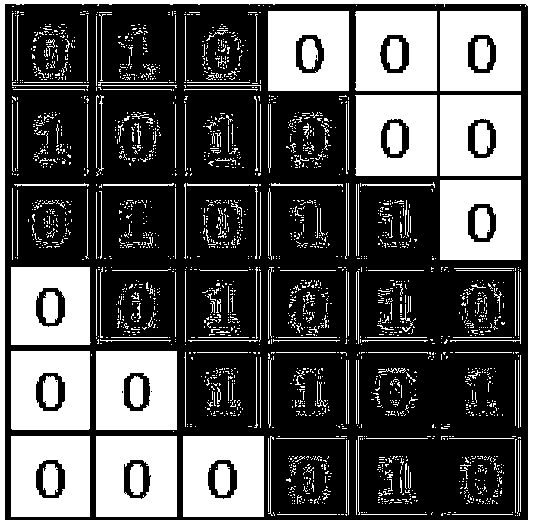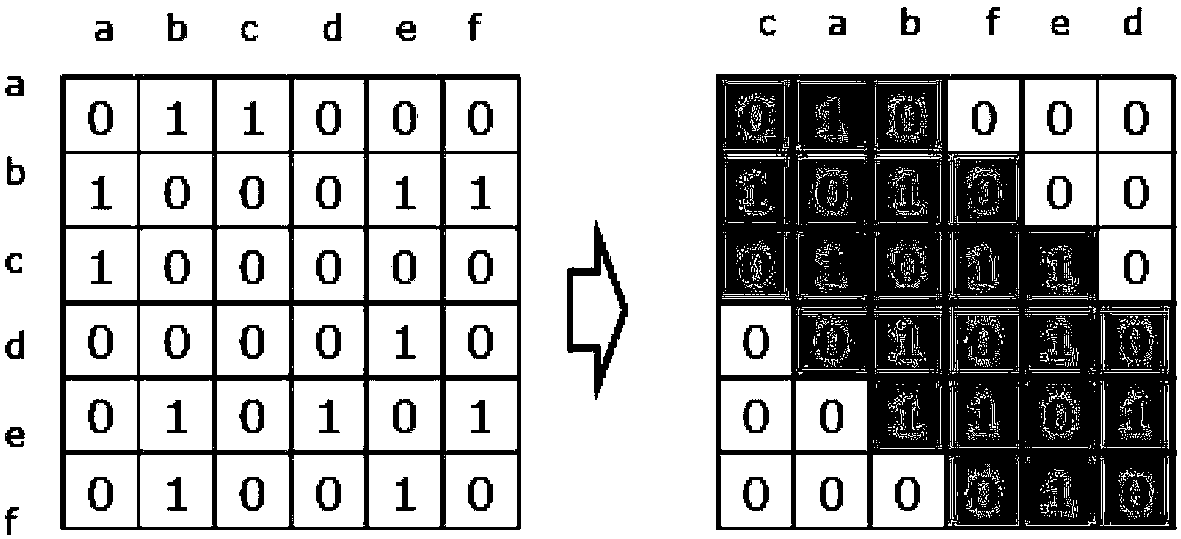Adjacency matrix-based graph feature extraction system, graph classification system and methods
An adjacency matrix and feature extraction technology, applied in the field of artificial intelligence, can solve the problems of inability to feature representation, process sensitivity, low classification accuracy, etc., to solve the limitation of computational complexity and window size, and improve accuracy and speed. , the effect of reducing computational complexity and amount of computation
- Summary
- Abstract
- Description
- Claims
- Application Information
AI Technical Summary
Problems solved by technology
Method used
Image
Examples
Embodiment 1
[0205] Taking a 6-vertex graph as an example, the graph feature extraction system based on the adjacency matrix in the computer environment of the present invention is described in detail. For this 6-vertex graph, each of its vertices is represented by a, b, c, d, e, f. In alphabetical order, the six sides are (a, b), (a, c), (b, e), (b, f), (e, f) and (e, d), its graph structure and its first adjacency matrix sorted according to this vertex are as follows Figure 9 shown.
[0206] The connection information regularization module reorders all vertices in the first adjacency matrix to obtain a second adjacency matrix, and the connection information elements in the second adjacency matrix are concentratedly distributed in the width of the second adjacency matrix is n Diagonal area of , wherein n is a positive integer, n>=2 and n is much smaller than |V|, where |V| is the number of rows (or columns) of the second adjacency matrix. The diagonal area with a width of n of the ...
Embodiment 2
[0226] This embodiment describes in detail the specific implementation of the adjacency matrix-based graph classification system in the computer environment of the present invention, and verifies the effect of this implementation by using a public dataset.
[0227] For datasets with irregularly sized graphs, it is necessary to find an appropriate window size n for it. When n is set too small, it may cause most graphs to lose connection information elements after passing through the connection information regularization module. In addition, too small n may lead to possible overfitting of the feature generation module, since fewer possible subgraph structural features are captured. First, we unify the size of the adjacency matrix of all graphs, and select the graph with the largest number of vertices |V| max The size (number of rows or columns) of the adjacency matrix as uniform. For vertices less than |V| max , such as a graph with 3 vertices, we use zero padding (append 0) ...
Embodiment 3
[0270] This embodiment mainly illustrates the important characteristic of the graph classification system based on the adjacency matrix proposed by the present invention: it can use a smaller window to capture a large multi-vertex subgraph structure.
[0271] Taking a graph consisting of ten vertices (|V|=10) as an example, Figure 28 The physical implications of using a feature generation module on this diagram are shown. It can be seen that the graph has two rings of size six vertices, and two vertices are shared by these two ring structures. To capture such ring-based graph patterns, existing methods usually require window sizes larger than 10. However, the method of the present invention is effective even when using only a window of size 6. consider Figure 28 In the figure on the upper left, we use the connection information regularization module to concentrate the connection information elements into the diagonal area of n=6, and reorder the vertices. The upper righ...
PUM
 Login to View More
Login to View More Abstract
Description
Claims
Application Information
 Login to View More
Login to View More - R&D
- Intellectual Property
- Life Sciences
- Materials
- Tech Scout
- Unparalleled Data Quality
- Higher Quality Content
- 60% Fewer Hallucinations
Browse by: Latest US Patents, China's latest patents, Technical Efficacy Thesaurus, Application Domain, Technology Topic, Popular Technical Reports.
© 2025 PatSnap. All rights reserved.Legal|Privacy policy|Modern Slavery Act Transparency Statement|Sitemap|About US| Contact US: help@patsnap.com



